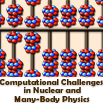Speaker
Prof.
Zhongzhou REN
(Nanjing University)
Description
One of fundamental properties of a nucleus is its radius
[1,2]. Experimental information on
nuclear charge radii can be obtained by different sources such as
electron scattering, muonic atom spectra, isotope shifts, and so
on [2,3]. These methods are successful for
the nuclei near the beta-stability line. However, it is
difficult for them to obtain charge radii of exotic nuclei and
superheavy nuclei, because these nuclei are produced by
experiments and exhibit short lifetimes so that they are not
available as target nuclei. In view of this, we propose a method
to determine nuclear charge radii from the decay data
[4-8]. As we all know, alpha
decay is the main decay mode of heavy and superheavy nuclei
[4-6]. We extract their charge radii from the
experimental alpha-decay data by the aid of the
well-established alpha-decay model [8]. The charge
distribution of daughter nuclei is determined in the
double-folding model to reproduce the experimental $\alpha$-decay
half-lives. The root-mean-square (rms) charge radius is then
calculated using the resulting charge distribution. Nuclear radii
of heavy and superheavy nuclei with Z=98-116 are extracted from
the alpha-decay data [6-8], for which alpha decay is
an unique tool to probe nuclear sizes at present. This is the
first result on nuclear charge radii of superheavy nuclei based on
the experimental alpha-decay data. Moreover, the rms charge
radii of some medium-mass proton-rich nuclei and light
neutron-rich nuclei are separately extracted from the experimental
data of proton emission and cluster radioactivity in a similar
manner [6-8].
References
[1] R. Hofstadter, Rev. Mod. Phys. 28, 214 (1956).
[2] I. Angeli and K. P. Marinova, At. Data Nucl. Data Tables 99, 69 (2013).
[3] Z. Wang and Z. Ren, Phys. Rev. C 70, 034303 (2004).
[4] Yu. Ts. Oganessian, J Phys. G: Nucl. Part. Phys. bf 34, R165 (2007).
[5] R.G. Lovas, R.J. Liotta, A. Insolia, K. Varga, and D.S. Delion, Phys. Rep. 294,
265 (1998).
[6] D. Ni, Z. Ren, T. Dong, and Y. Qian, Phys. Rev. C 87, 024310 (2013).
[7] Y. Qian, Z. Ren, and D. Ni, Phys. Rev. C 87, 054323 (2013).
[8] D. Ni and Z. Ren, Phys. Rev. C 80 051303(R) (2009); Phys. Rev. C 81,
024315 (2010).
Author
Prof.
Zhongzhou REN
(Nanjing University)

